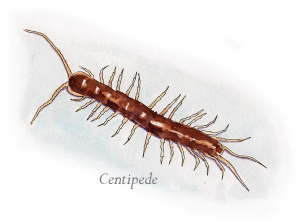https://www.wildernessmedicinenewsletter.com/wp-content/uploads/2014/10/wmnlogo20151.png00WMN Editorshttps://www.wildernessmedicinenewsletter.com/wp-content/uploads/2014/10/wmnlogo20151.pngWMN Editors2013-12-04 20:50:502013-12-04 20:50:50THE USE OF MEDICAL OXYGEN IN EMS
This is a short article to compare and contrast Centipedes and Millipedes. Centipedes are venomous and can cause a painful bite, while Millipedes have no venom and pose no danger to humans.
Centipedes:Millipedes:
KINGDOM AnimaliaAnimalia
PHYLUM ArthropodaArthropoda
SUBPHYLUM MyriapodaMyriapoda
CLASSChilipoda Diplopoda
CENTIPEDES:
These are not Arachnids; they are Chilipoda.
They are predatory – eat insects, worms, and millipedes.
They have a pair of legs for each segment, 20 to over 300 pairs.
They have a pair of venom claws on the front segment, and they do produce venom used to killed and subdue their prey.
Size: 4mm (1/4”) to 30cm (12”).
8000 species of centipedes.
They have a venomous sting that is painful but not dangerous.
The only danger is the risk of an allergic reaction or anaphylaxis.
https://www.wildernessmedicinenewsletter.com/wp-content/uploads/2014/10/wmnlogo20151.png00WMN Editorshttps://www.wildernessmedicinenewsletter.com/wp-content/uploads/2014/10/wmnlogo20151.pngWMN Editors2013-10-23 15:43:072013-12-02 13:49:27SCORPIONS and The WORLD OF ARACHNIDS
THE USE OF MEDICAL OXYGEN IN EMS
/in Asthma, Medical Response, Medications, Oxygen, Shortness of breath/by WMN EditorsISSN-1059-6518
Volume 26 Number 4
By Frank Hubbell, DO
Illustrations By T.B.R. Walsh
MEDICAL OXYGEN (O2):
To be used on anyone who is exhibiting signs and symptoms of hypoxia:
Shortness of breath
Increase or decrease in respiratory rate
– Adult: respiratory rate less than 10 or greater than 30
– Child (1 year – 12 years old): respiratory rate less than 15 or greater than 30
– Infant (0 – 12 months old): respiratory rate less than 25 or greater than 50
Increase in heart rate.
Change in level of consciousness.
Change in skin color: pallor or cyanosis.
Never, ever withhold oxygen from someone who appears to need it.
The following is needed to provide supplemental oxygen to a patient:
✔ O2 tank
✔ Regulator
✔ Delivery device – O2 mask
Medical Oxygen Storage Tanks:
Come in various sizes.
✔ Are identified by color– either the entire tank is green or the curved part of the tank, “the shoulder,” is green
✔ Have an identifying yellow, diamond shaped label on the tank that is marked U.S.P. and Oxygen
✔ Full tanks contain 2000 PSI of pressure and must be handled properly.
Read more
CENTIPEDES and MILLIPEDES
/in Bites and Stings, Rash, Skin itching/by WMN EditorsCENTIPEDES and MILLIPEDES
By Frank Hubbell, DO
Illustrations by T.B.R. Walsh
This is a short article to compare and contrast Centipedes and Millipedes. Centipedes are venomous and can cause a painful bite, while Millipedes have no venom and pose no danger to humans.
Centipedes: Millipedes:
KINGDOM Animalia Animalia
PHYLUM Arthropoda Arthropoda
SUBPHYLUM Myriapoda Myriapoda
CLASS Chilipoda Diplopoda
CENTIPEDES:
These are not Arachnids; they are Chilipoda.
They are predatory – eat insects, worms, and millipedes.
They have a pair of legs for each segment, 20 to over 300 pairs.
They have a pair of venom claws on the front segment, and they do produce venom used to killed and subdue their prey.
Size: 4mm (1/4”) to 30cm (12”).
8000 species of centipedes.
They have a venomous sting that is painful but not dangerous.
The only danger is the risk of an allergic reaction or anaphylaxis.
Read more
SCORPIONS and The WORLD OF ARACHNIDS
/in Bites and Stings, Environemtal Injuries, Poisons/by WMN EditorsISSN-1059-6518
The WORLD OF ARACHNIDS
Dangerous to Humans
By Frank Hubbell, DO
Illustrations by T.B.R. Walsh
KINGDOM – Animalia
PHYLUM – Arthropoda
SUBPHYLUM – Chelicerada
CLASS – Arachnida
Arachnids:
They are joint-legged invertebrate animals.
They have eight legs, the front two may be modified into fangs or jaws.
There are over 100,000 named species.
There are 11 Orders of Arachnida:
Potentially dangerous to humans:
Araneae – spiders
Scorpiones – scorpions
Acari – ticks and mites
Harmless to humans:
Scolifugae – camel spiders, wind scorpions, sun spiders, solifuges
Opiliones – harvestmen (daddy longlegs)
Amblypygi – tailless whipscorpions and whip spiders
Palpigradi – micro whipscorpions
Pseudoscorpion – pseudoscorpion, bookscorpion, or false scorpion
Ricinulei – ricinuleids or hooded tick spiders
Schizomida – schizomids or shorttailled whipscorpion
Thelyphonida – whiptailed scorpion, vinegaroons, uropygids
Read more
Japanese Encephalitis
/in Bites and Stings, Disease, Immunizations, Infection, Japanese Encephalitis/by WMN EditorsISSN-1059-6518
Travel Immunizations
Japanese Encephalitis
By Frank Hubbell, DO
Japanese Encephalitis (JE) is more correctly known as Japanese B Encephalitis.
It is a virus in the family Flaviviridae.
The reservoirs in nature that harbor the JE virus are pigs and herons.
The vector for JE is the mosquito – Culex tritaeniorhynchus & C. vishnui.
JE is not contagious, in that it cannot be transferred from human-to-human. It has to be spread by the Culex mosquito vector.
The incubation period from mosquito bite to symptoms is 5 – 15 days.
The vast majority of those infected are asymptomatic.
Only 1 in 250 cases develops into encephalitis.
Still JE is the leading cause of encephalitis in Asia with 30,000 – 50,000 cases per year.
One in four patients that develop JE encephalitis will die. There is a 25% fatality rate caused by brain damage.
Read more